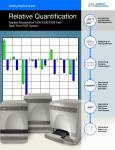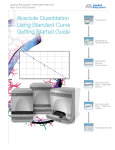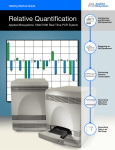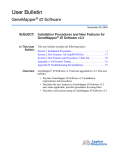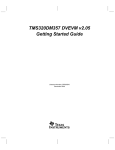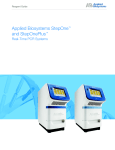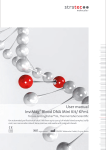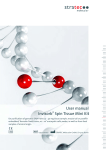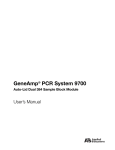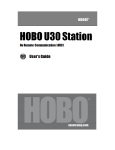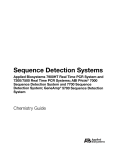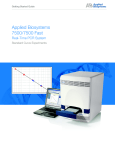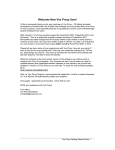Download Applied Biosystems 7300/7500 Real Time PCR System Plus/Minus
Transcript
Getting Started Guide
Plus/Minus Assay
Introduction
Applied Biosystems 7300/7500 Real Time PCR System
Designing a
Plus/Minus
Experiment
Setting Up
the Reaction
Performing a
Plus/Minus
Pre-Read Run
Generating
Amplification
Data
Performing a
Plus/Minus
Post-Read Run
© Copyright 2004, Applied Biosystems. All rights reserved.
For Research Use Only. Not for use in diagnostic procedures.
Authorized Thermal Cycler
This instrument, Serial No___________, is an Authorized Thermal Cycler. Its purchase price includes the up-front fee
component of a license under United States Patent Nos. 4,683,195, 4,683,202 and 4,965,188, owned by Roche
Molecular Systems, Inc., and under corresponding claims in patents outside the United States, owned by F. HoffmannLa Roche Ltd, covering the Polymerase Chain Reaction ("PCR") process to practice the PCR process for internal
research and development using this instrument. The running royalty component of that license may be purchased
from Applied Biosystems or obtained by purchasing Authorized Reagents. This instrument is also an Authorized
Thermal Cycler for use with applications licenses available from Applied Biosystems. Its use with Authorized
Reagents also provides a limited PCR license in accordance with the label rights accompanying such reagents.
Purchase of this product does not itself convey to the purchaser a complete license or right to perform the PCR
process. Further information on purchasing licenses to practice the PCR process may be obtained by contacting the
Director of Licensing at Applied Biosystems, 850 Lincoln Centre Drive, Foster City, California 94404.
DISCLAIMER OF LICENSE: No rights for any application, including any in vitro diagnostic application, are
conveyed expressly, by implication or by estoppel under any patent or patent applications claiming homogeneous or
real-time detection methods, including patents covering such methods used in conjunction with the PCR process or
other amplification processes. The 5' nuclease detection assay and certain other homogeneous or real-time
amplification and detection methods are covered by United States Patent Nos. 5,210,015, 5,487,972, 5,804,375 and
5,994,056, owned by Roche Molecular Systems, Inc.; by corresponding patents and patent applications outside the
United States, owned by F. Hoffmann-La Roche Ltd; and by United States Patent Nos. 5,538,848 and 6,030,787, and
corresponding patents and patent applications outside the United States, owned by Applera Corporation. Purchase of
this instrument conveys no license or right under the foregoing patents. Use of these and other patented processes in
conjunction with the PCR process requires a license. For information on obtaining licenses, contact the Director of
Licensing at Applied Biosystems, 850 Lincoln Centre Drive, Foster City, California 94404, or The Licensing
Department, Roche Molecular Systems, Inc., 1145 Atlantic Avenue, Alameda, California, 94501, USA.
Information in this document is subject to change without notice. Applied Biosystems assumes no responsibility for
any errors that may appear in this document. This document is believed to be complete and accurate at the time of
publication. In no event shall Applied Biosystems be liable for incidental, special, multiple, or consequential damages
in connection with or arising from the use of this document.
TRADEMARKS:
Applied Biosystems, ROX, VIC, TAMRA, MicroAmp, and Primer Express are registered trademarks of
Applera Corporation or its subsidiaries in the U.S. and/or certain other countries.
AB (Design), Applera, ABI PRISM, BloodPrep, Celera Genomics, FAM, iScience, iScience (Design), NucPrep, and
PrepMan are trademarks of Applera Corporation or its subsidiaries in the U.S. and/or certain other countries.
TaqMan is a registered trademark of Roche Molecular Systems, Inc.
ii
Plus/Minus Getting Started Guide for the 7300/7500 System
SAMPLE DOCUMENT
Part Number 4347821 Rev. A
1/2004
December 18, 2003 3:26 pm, PlusMinus_FrontCover.fm
All other trademarks are the sole property of their respective owners.
Plus/Minus Experiment
Workflow
Chapter 1
Introduction
About the
7300/7500 system
Chapter 2
Designing
a Plus/Minus
Experiment
Use TaqMan
probe-based reagent
configuration
Chapter 3
December 18, 2003 3:26 pm, GSG_PM_Workflow.fm
SAMPLE DOCUMENT
Chapter 4
Setting Up
the Reaction
Performing
the Plus/Minus
Pre-Read Run
Chapter 5
Generating
Amplification
Data
Chapter 6
Performing
the Plus/Minus
Post-Read Run
Plus/Minus Getting Started Guide for the 7300/7500 System
Prepare DNA
Create a Plus/Minus
plate document
Create a plate
document for
sample amplification
Perform a
post-read run
About Plus/Minus
assays using IPC
About Plus/Minus
assays
Example Plus/Minus
experiment
Design the probe
and primers
Set up reaction plate
Perform the
pre-read run
Start the
amplification run
View
Plus/Minus results
Export plate
documents
iii
iv
December 18, 2003 3:26 pm, GSG_PM_Workflow.fm
SAMPLE DOCUMENT
Plus/Minus Getting Started Guide for the 7300/7500 System
Contents
Plus/Minus Experiment Workflow
iii
Preface
vii
How to Use This Guide . . . . . . . . . . . . . . . . . . . . . . . . . . . . . . . . . . . . . . . . . . . . . . . . vii
How to Obtain More Information . . . . . . . . . . . . . . . . . . . . . . . . . . . . . . . . . . . . . . . . .viii
How to Obtain Services and Support . . . . . . . . . . . . . . . . . . . . . . . . . . . . . . . . . . . . . viii
Send Us Your Comments . . . . . . . . . . . . . . . . . . . . . . . . . . . . . . . . . . . . . . . . . . . . . . viii
Chapter 1
Introduction
1
Overview . . . . . . . . . . . . . . . . . . . . . . . . . . . . . . . . . . . . . . . . . . . . . . . . . . . . . . . . . . . . .1
About the 7300/7500 System . . . . . . . . . . . . . . . . . . . . . . . . . . . . . . . . . . . . . . . . . . . . .2
About Plus/Minus Assays Using an IPC . . . . . . . . . . . . . . . . . . . . . . . . . . . . . . . . . . . . .2
About Plus/Minus Assays . . . . . . . . . . . . . . . . . . . . . . . . . . . . . . . . . . . . . . . . . . . . . . . .4
Example Plus/Minus Experiment . . . . . . . . . . . . . . . . . . . . . . . . . . . . . . . . . . . . . . . . . .6
Chapter 2
Designing a Plus/Minus Experiment
13
Workflow . . . . . . . . . . . . . . . . . . . . . . . . . . . . . . . . . . . . . . . . . . . . . . . . . . . . . . . . . . . .13
Using TaqMan® Probe-Based Reagent Configuration . . . . . . . . . . . . . . . . . . . . . . . . .14
Designing the Probe and Primers . . . . . . . . . . . . . . . . . . . . . . . . . . . . . . . . . . . . . . . . .15
Chapter 3
Setting Up the Reaction Plate
17
Workflow . . . . . . . . . . . . . . . . . . . . . . . . . . . . . . . . . . . . . . . . . . . . . . . . . . . . . . . . . . . .17
Preparing DNA . . . . . . . . . . . . . . . . . . . . . . . . . . . . . . . . . . . . . . . . . . . . . . . . . . . . . . .18
December 18, 2003 3:26 pm, GSG_TOC.fm
SAMPLE DOCUMENT
Setting Up the Reaction Plate . . . . . . . . . . . . . . . . . . . . . . . . . . . . . . . . . . . . . . . . . . . .19
Chapter 4
Performing the Plus/Minus Pre-Read Run
21
Workflow . . . . . . . . . . . . . . . . . . . . . . . . . . . . . . . . . . . . . . . . . . . . . . . . . . . . . . . . . . . .21
The Pre-Read Run . . . . . . . . . . . . . . . . . . . . . . . . . . . . . . . . . . . . . . . . . . . . . . . . . . . .22
Before You Begin . . . . . . . . . . . . . . . . . . . . . . . . . . . . . . . . . . . . . . . . . . . . . . . . . . . . .22
Creating a Plus/Minus Plate Document . . . . . . . . . . . . . . . . . . . . . . . . . . . . . . . . . . . .22
Performing the Pre-Read Run . . . . . . . . . . . . . . . . . . . . . . . . . . . . . . . . . . . . . . . . . . . .28
Plus/Minus Getting Started Guide for the 7300/7500 System
v
Chapter 5
Generating Amplification Data
31
Workflow . . . . . . . . . . . . . . . . . . . . . . . . . . . . . . . . . . . . . . . . . . . . . . . . . . . . . . . . . . . . 31
Creating a Plate Document for Sample Amplification . . . . . . . . . . . . . . . . . . . . . . . . . 32
Performing the Amplification Run . . . . . . . . . . . . . . . . . . . . . . . . . . . . . . . . . . . . . . . . . 36
Chapter 6
Performing the Plus/Minus Post-Read Run
39
Workflow . . . . . . . . . . . . . . . . . . . . . . . . . . . . . . . . . . . . . . . . . . . . . . . . . . . . . . . . . . . . 39
Performing the Post-Read Run . . . . . . . . . . . . . . . . . . . . . . . . . . . . . . . . . . . . . . . . . . . 40
Viewing Plus/Minus Results . . . . . . . . . . . . . . . . . . . . . . . . . . . . . . . . . . . . . . . . . . . . . 43
Exporting Plus/Minus Plate Data . . . . . . . . . . . . . . . . . . . . . . . . . . . . . . . . . . . . . . . . . 47
Appendix A Creating Detectors
49
Appendix B Viewing Amplification Data
51
Specifying Analysis Settings . . . . . . . . . . . . . . . . . . . . . . . . . . . . . . . . . . . . . . . . . . . . . 51
Analyzing the Plus/Minus Amplification Data (AQ Plate) . . . . . . . . . . . . . . . . . . . . . . . 52
Viewing the Amplification Data . . . . . . . . . . . . . . . . . . . . . . . . . . . . . . . . . . . . . . . . . . . 53
References
Plus/Minus Getting Started Guide for the 7300/7500 System
December 18, 2003 3:26 pm, GSG_TOC.fm
vi
SAMPLE DOCUMENT
Index
Preface
How to Use This Guide
Purpose of This
Guide
Assumptions
This manual is written for principal investigators and laboratory staff who run
plus/minus assays using the Applied Biosystems 7300/7500 Real Time PCR System
(7300/7500 system).
This guide assumes that you have:
• Familiarity with Microsoft® Windows® XP operating system.
• Knowledge of general techniques for handling DNA samples and preparing them
for PCR.
• A general understanding of hard drives and data storage, file transfers, and copying
and pasting.
If you want to integrate the 7300/7500 system into your existing laboratory data flow
system, you need networking experience.
December 18, 2003 3:26 pm, GSG_Preface.fm
DRAFT
Text Conventions
This guide uses the following conventions:
• Bold indicates user action. For example:
Type 0, then press Enter for each of the remaining fields.
• Italic text indicates new or important words and is also used for emphasis. For
example:
Before analyzing, always prepare fresh matrix.
• A right arrow bracket (>) separates successive commands you select from a dropdown or shortcut menu. For example:
Select File > Open > Spot Set.
User Attention
Words
Two user attention words appear in this Applied Biosystems user documentation. Each
word implies a particular level of observation or action as described below:
Note: Provides information that may be of interest or help but is not critical to the use of
the product.
IMPORTANT! Provides information that is necessary for proper instrument operation,
accurate chemistry kit use, or safe use of a chemical.
Safety
Refer to the Applied Biosystems 7300/7500 Real Time PCR System Installation and
Maintenance Getting Started Guide (PN 4347828) and the Applied Biosystems
7300/7500 Real Time PCR System Site Preparation Guide (PN 4347823) for important
safety information.
Plus/Minus Getting Started Guide for the 7300/7500 System
vii
Preface
How to Obtain More Information
How to Obtain More Information
For more information about using the 7300/7500 system, refer to:
• Applied Biosystems 7300/7500 Real Time PCR System Online Help
• Applied Biosystems 7300/7500 Real Time PCR System Allelic Discrimination
Getting Started Guide (PN 4347822)
• Applied Biosystems 7300/7500 Real Time PCR System Absolute Quantification
Getting Started Guide (PN 4347825)
• Applied Biosystems 7300/7500 Real Time PCR System Relative Quantification
Getting Started Guide (PN 4347824)
• Applied Biosystems 7300/7500 Real Time PCR System Installation and
Maintenance Getting Started Guide (PN 4347828)
• Applied Biosystems 7300/7500 Real Time PCR System Site Preparation Guide
(PN 4347823)
• Sequence Detection Systems Chemistry Guide (PN 4348358)
How to Obtain Services and Support
For the latest services and support information for all locations, go to
http://www.appliedbiosystems.com, then click the link for Support.
• Search through frequently asked questions (FAQs)
• Submit a question directly to Technical Support
• Order Applied Biosystems user documents, MSDSs, certificates of analysis, and)
other related documents
• Download PDF documents
• Obtain information about customer training
• Download software updates and patches
In addition, the Services and Support page provides access to worldwide telephone and
fax numbers to contact Applied Biosystems Technical Support and Sales facilities.
Send Us Your Comments
Applied Biosystems welcomes your comments and suggestions for improving its user
documents. You can e-mail your comments to:
DRAFT
[email protected]
viii
Plus/Minus Getting Started Guide for the 7300/7500 System
December 18, 2003 3:26 pm, GSG_Preface.fm
At the Support page, you can:
Introduction
Chapter 1
1
Overview
Introduction
Designing
a Plus/Minus
Experiment
December 18, 2003 3:26 pm, GSG_Chapter1.fm
DRAFT
Setting Up
the Reaction
About the
7300/7500 system
See page 2
About Plus/Minus assays
using an IPC
See page 2
About Plus/Minus
assays
See page 4
Example
Plus/Minus experiment
See page 6
Performing
the Plus/Minus
Pre-Read Run
Generating
Amplification
Data
Performing
the Plus/Minus
Post-Read Run
Notes
Plus/Minus Getting Started Guide for the 7300/7500 System
1
Chapter 1 Introduction
About the 7300/7500 System
About the 7300/7500 System
Description
The Applied Biosystems Real Time PCR System (7300/7500 system) uses fluorescentbased PCR chemistries to provide:
• Quantitative detection of nucleic acid sequence using real-time analysis.
• Qualitative detection of nucleic acid sequence using end-point and dissociationcurve analysis.
Plus/Minus Assay
The 7300/7500 system allows you to perform several assay types with plates or tubes in
the 96-well format. This guide describes the plus/minus assay which determines whether
or not a specific target sequence is present in a sample.
Note: For information about the other assay types, refer to the Sequence Detection
Systems Chemistry Guide (PN 4348358) and the Online Help for the 7300/7500
system.
Definition
A plus/minus assay is an end point assay that determines if a specific target sequence is
present (plus) or not present (minus) in a sample. In an end-point assay, data are
collected at the end of the PCR process.
What Is An IPC?
An IPC is an internal positive control (see TaqMan® Exogenous Internal Positive
Control Reagents kit, PN 4308323) that is used in plus/minus assays to monitor the PCR
process and to ensure that a negative result is not due to failed PCR. The IPC consists of
a template, a primer set, and a dye-labeled (VIC) probe that are added to each well of a
reaction plate (the IPC is part of the reaction mix, see “Preparing the PCR Reaction Mix”
on page 20).
Plus/Minus assays with an IPC use fluorogenic 5′ nuclease chemistry (also known as
“TaqMan probe-based chemistry”). During amplification, the sample target and the IPC
target generate reporter fluorescence signals such that positive or negative calls may be
made on unknown samples.
Note: The SYBR® Green I dye chemistry is not supported for plus/minus assays
DRAFT
using an IPC.
Notes
2
Plus/Minus Getting Started Guide for the 7300/7500 System
December 18, 2003 3:26 pm, GSG_Chapter1.fm
About Plus/Minus Assays Using an IPC
About Plus/Minus Assays Using an IPC
Terms Used in Plus/Minus Analysis
Term
Definition
Internal positive control (IPC)
A second TaqMan probe and primer set
added to the reaction plate to monitor the
PCR process and to ensure that a negative
result is not due to failed PCR in the sample
No amplification control (NAC)
Wells that contain no target template and
blocked IPC (the IPC target template has
been blocked by a blocking agent)
No template control (NTC)
A sample that contains no target template
Nucleic acid target
Nucleotide sequence that you want to
identify as present or absent
Unknown sample (U)
The sample for which you want to determine
the presence or absence of a specific target
1
December 18, 2003 3:26 pm, GSG_Chapter1.fm
DRAFT
Terms Used in
Plus/Minus
Analysis
Notes
Plus/Minus Getting Started Guide for the 7300/7500 System
3
Chapter 1 Introduction
About Plus/Minus Assays
About Plus/Minus Assays
Plus/Minus
Experiment
Workflow
This document uses the term “plus/minus assay” to refer to the entire process of
analyzing samples of extracted DNA from data collected at the end of the PCR process.
After you design the experiment and isolate DNA, a plus/minus assay involves
performing:
• A pre-read run on a plus/minus plate document to determine the baseline
fluorescence associated with primers and probes before amplification.
• An amplification run using an AQ plate document to generate real-time PCR data,
which can be used to analyze and troubleshoot the PCR data for the plus/minus
assay, if needed.
• A post-read run using the original plus/minus plate document, which
automatically subtracts the baseline fluorescence determined during the pre-read
run to calculate the result.
The following figure illustrates the complete process.
Pre-Read Run
Amplification Run
Post-Read Run
Notes
4
Plus/Minus Getting Started Guide for the 7300/7500 System
December 18, 2003 3:26 pm, GSG_Chapter1.fm
7300/7500 System
DRAFT
Reaction Plate
About Plus/Minus Assays
Required User-Supplied Materials
Required UserSupplied
Materials
Item
Source
1
DNA isolation and purification chemistry
systems:
• ABI PRISM™ 6100 Nucleic Acid
PrepStation
• Applied Biosystems (PN 6100-01)
• BloodPrep™ Chemistry (genomic DNA
from fresh or frozen blood or cells)
• Applied Biosystems (PN 4346860)
• NucPrep™ Chemistry (DNA from animal
and plant tissue)
• Applied Biosystems (PN 4340274)
• PrepMan™ Ultra Sample Preparation
Reagent Kit
• Applied Biosystems (PN 4322547)
December 18, 2003 3:26 pm, GSG_Chapter1.fm
DRAFT
Labeled primers and probes source:
• Primer Express Software (customdesigned primers and probes)
• PN 4330710 (1-user license)
PN 4330709 (10-user license)
PN 4330708 (50-user license)
MicroAmp® Optical 96-Well Reaction Plates
Applied Biosystems (PN 4306757)
Optical Adhesive Covers
Applied Biosystems (PN 4311971)
Reagent tubes with caps, 10-mL
Applied Biosystems (PN 4305932)
TaqMan® Exogenous Internal Positive
Control Reagents (VIC® Probe)
Applied Biosystems (PN 4308323)
TaqMan® Universal PCR Master Mix
Applied Biosystems (PN 4304437)
Centrifuge with adapter for 96-well plates
Major Laboratory Supplier (MLS)
Gloves
MLS
Microcentrifuge
MLS
Microcentrifuge tubes, sterile 1.5-mL
MLS
Nuclease-free water
MLS
Pipette tips, with filter plugs
MLS
Pipettors, positive-displacement
MLS
Tris-EDTA (TE) Buffer, pH 8.0
MLS
Vortexer
MLS
Notes
Plus/Minus Getting Started Guide for the 7300/7500 System
5
Chapter 1 Introduction
Example Plus/Minus Experiment
Example Plus/Minus Experiment
Overview
To better illustrate how to design, perform, and analyze plus/minus experiments, this
section provides an example experiment. The example experiment represents a typical
plus/minus experiment that you can use as a quick-start procedure to familiarize yourself
with the plus/minus workflow. Details about the plus/minus workflow are described in
the subsequent chapters of this guide. Example Experiment boxes appear in subsequent
chapters to illustrate workflow details.
Description
The objective of the example plus/minus experiment is to determine if an E. coli target
sequence is present or not present in each batch of hamburger meat. The experiment uses
duplex PCR where a set of primers and a VIC-labeled probe for the IPC plus a set of
primers and a FAM-labeled probe for the target E. coli sequence are run together in each
reaction. The set of primers/probe for detecting E. coli was custom designed by Applied
Biosystems Primer Express® software.
Reactions were set up for PCR using the TaqMan® Universal PCR Master Mix and
appropriate primers and probes.
The example plus/minus experiment data and results were generated using a 7300/7500
system by performing:
Notes
6
Plus/Minus Getting Started Guide for the 7300/7500 System
December 18, 2003 3:26 pm, GSG_Chapter1.fm
DRAFT
• A pre-read run on a plus/minus plate to determine the baseline fluorescence
associated with primers and probes before amplification.
• An amplification run using an AQ plate document to generate real-time PCR data,
which can be used to analyze and troubleshoot the PCR data for the plus/minus
assay, if needed.
• A post-read run using the original plus/minus plate document, which
automatically subtracts the pre-read baseline fluorescence determined during the
pre-read run, then assigns positive or negative calls using the amplified data.
Example Plus/Minus Experiment
Example Plus/Minus Experiment Procedure
Example Plus/Minus Experiment
Procedure
1
Design the experiment and prepare DNA:
1. Design the experiment as explained in Chapter 2.
a. Order the TaqMan® Exogenous Internal
Positive Control Reagents kit and the
TaqMan® Universal PCR Master Mix.
b. Design the primers and FAM-labeled probe
set for E. coli detection with Applied
Biosystems Primer Express software.
2. Extract DNA from samples (see “Preparing
DNA” on page 18) using the PrepMan Ultra
Sample Preparation Reagent Kit (PN 4322547)
and protocol (PN 4318925) to obtain a final
concentration of 10 ng/µL of DNA for each
sample.
3. Prepare sufficient reaction mix (see “Preparing
CHEMICAL HAZARD.
TaqMan Universal PCR Master Mix may
cause eye and skin irritation. Exposure may
cause discomfort if swallowed or inhaled. Read
the MSDS, and follow the handling instructions.
Wear appropriate protective eyewear, clothing,
and gloves.
Volume for one
Reaction
Final
Concentration
TaqMan®
Universal PCR
Master Mix (2✕)
25.0
1✕
10✕ Exo IPC Mix
(IPC kit)
5.0
50 to 900 nM
50✕ Exo IPC
DNA (IPC kit)
1.0
50 to 900 nM
Target primers,
probe, and
deionized water
14.0
50 to 250 nM
Total
45.0
—
Item
4. Prepare the reaction plate:
a. Pipette 45 µL of the reaction mixture into
NAC
NA
NT
TC
T
Cp
plus
us IPC
IPC
each well of a 96-well reaction plate.
b. Pipette 5 µL of IPC block, TE or water, or
unknown sample into the designated wells
of a 96-well plate such as the example
indicated in the table to the right. (see
“Setting Up the Reaction Plate” on
page 19).
Note: The final reaction volume in each
well is 50 µL.
GR2363
December 18, 2003 3:26 pm, GSG_Chapter1.fm
DRAFT
the PCR Reaction Mix” on page 20) by using the
volumes as listed in the table on the right.
Notes
Plus/Minus Getting Started Guide for the 7300/7500 System
7
Chapter 1 Introduction
Example Plus/Minus Experiment
c. Keep the reaction plate on ice until you are
ready to load it into the 7300/7500 system.
Wells
If preparing...
Add
A1 to A6
NAC a
5 µL of 10✕ Exo
IPC Block
A7 to A12
NTC b
5 µL of 1✕ TE or
H2O
B1 to H12
Uc
5 µL of sample
being tested for
E. coli
a. No Amplification Control – Well contains no target template and
no IPC.
b. No Template Control – Well contains no target template, only IPC.
c. Unknown – Well contains both target template and IPC.
Perform the pre-read run:
1. Create a plus/minus plate document:
Follow the instructions as described in
Chapter 4. Briefly, in the New Document
Wizard,
a. Select File > New.
b. Select Plus/Minus in the Assay drop-down
list.
c. In the Plate Name field, type Plus/Minus
Pre-Read, then click Next.
d. Add detectors to the plate document (see
Appendix A, Creating Detectors) then click
Next.
e. Specify detectors and tasks for each well,
f. Double-click each well to type the sample
name, then save the document.
2. Enter the sample names and specify tasks in the
Well Inspector (View > Well Inspector).
DRAFT
IMPORTANT! If your experiment does not use
all the wells on a plate, do not omit the wells
from use at this point. You can omit unused
wells after the run is completed. For more
information about omitting wells, refer to the
Online Help.
Notes
8
Plus/Minus Getting Started Guide for the 7300/7500 System
December 18, 2003 3:26 pm, GSG_Chapter1.fm
then click Finish.
Example Plus/Minus Experiment
Example Plus/Minus Experiment Procedure
3. Perform the plus/minus pre-read run.
a. Select the Instrument tab. By default, the
1
standard PCR conditions are displayed.
b. Select File > Save As, type a name for the
plus/minus plate document, then click Save.
c. Load the reaction plate into the instrument.
December 18, 2003 3:26 pm, GSG_Chapter1.fm
DRAFT
d. Click Pre-Read.
Notes
Plus/Minus Getting Started Guide for the 7300/7500 System
9
Chapter 1 Introduction
Example Plus/Minus Experiment
Amplify the DNA:
1. Create an AQ plate document for amplification:
Follow the instructions as described in
Chapter 5. Briefly, in the New Document
Wizard,
a. Select File > New.
b. Select Absolute Quantification (Standard
Curve) in the Assay drop-down list.
c. In the Plate Name field, type Plus/Minus
Amplification, then click Next.
Note: A standard curve is not needed for a
non-quantification amplification run.
d. Add detectors to the plate document (see
Appendix A), then click Next.
e. Specify the detectors and tasks for each
well, then click Finish.
f. Type the sample names, then save the
document.
2. Perform the plus/minus amplification run.
a. Select the Instrument tab.
b. Select File > Save As, type a name for the
AQ Plate document, then click Save.
DRAFT
then click Start.
By default, the standard PCR conditions for
the PCR step are displayed.
After the run, a message indicates if the run
is successful, or if errors were encountered.
Notes
10
Plus/Minus Getting Started Guide for the 7300/7500 System
December 18, 2003 3:26 pm, GSG_Chapter1.fm
c. Load the reaction plate into the instrument,
Example Plus/Minus Experiment
Example Plus/Minus Experiment Procedure
Perform the plus/minus post-read run:
1. Open the plus/minus pre-read plate document,
1
then use it to perform the post-read run. (See
“Performing the Post-Read Run” on page 40.)
a. Select the Instrument tab.
b. Select File > Save As, type a name for the
plus/minus post-read plate document, then
click Save.
c. Load the reaction plate into the instrument.
d. Click Post-Read.
e. Click
or select Analysis > Analyze.
Click the Results tab to view results for
each well.
2. If you need to troubleshoot the plus/minus
December 18, 2003 3:26 pm, GSG_Chapter1.fm
DRAFT
results, see “Viewing Amplification Data” on
page 51.
Notes
Plus/Minus Getting Started Guide for the 7300/7500 System
11
Chapter 1 Introduction
Notes
12
Plus/Minus Getting Started Guide for the 7300/7500 System
December 18, 2003 3:26 pm, GSG_Chapter1.fm
DRAFT
Example Plus/Minus Experiment
Chapter 2
Designing a Plus/Minus
Experiment
Workflow
2
Introduction
Designing
a Plus/Minus
Experiment
Setting Up
the Reaction
December 18, 2003 3:26 pm, GSG_Chapter2.fm
DRAFT
Using TaqMan probe-based
reagent configuration
See page 14
Performing
the Plus/Minus
Pre-Read Run
Generating
Amplification
Data
Design the probe
and primers
See page 15
Performing
the Plus/Minus
Post-Read Run
Notes
Plus/Minus Getting Started Guide for the 7300/7500 System
13
Chapter 2 Designing a Plus/Minus Experiment
Using TaqMan® Probe-Based Reagent Configuration
Using TaqMan® Probe-Based Reagent Configuration
Plus/minus assays with an IPC use the fluorogenic 5′ nuclease chemistry (also known as
TaqMan® probe-based chemistry).
Chemistry
TaqMan® reagents or kits
Process
Polymerization
Description
TaqMan probe-based
chemistry uses a
fluorogenic probe to detect
a specific PCR product as it
accumulates during PCR
cycles.
FORWARD
PRIMER
Strand Displacement
R
PROBE
5′
3′
R = REPORTER
Q
3′
R
Q = QUENCHER
5′
5′
3′
5′
REVERSE
PRIMER
Q
5′
3′
3′
5′
5′
Step 1: A reporter (R) and a
quencher (Q) are attached to the
5' and 3' ends of a TaqMan
probe.
3′
5′
Step 1 continued: when both dyes
are attached to the probe, reporter
dye emission is quenched.
Cleavage
Polymerization Completed
R
R
Q
3′
5′
3′
5′
5′
3′
5′
Step 2: During each extension
cycle, the AmpliTaq Gold® DNA
polymerase cleaves the reporter
dye from the probe.
5′
3′
Q
3′
5′
5′
3′
5′
Step 3: After being separated from
the quencher, the reporter dye
emits its characteristic
fluorescence.
For more information about the TaqMan probe-based chemistry, refer to the Sequence
Detection Systems Chemistry Guide (PN 4348358).
The following reagents are available from Applied Biosystems for designing and
running plus/minus assays.
Kit
Part
Number
TaqMan® Exogenous Internal Positive Control Reagents with TaqMan
Universal PCR Master Mix
4308323
TaqMan® Universal PCR Master Mix
4304437
Note: The IPC DNA, primers, and probe supplied in these reagents can be used with all
sample target systems. Refer to the TaqMan® Universal PCR Master Mix Protocol
(PN 4304449) for instructions on optimizing amplification of your target.
Notes
14
Plus/Minus Getting Started Guide for the 7300/7500 System
DRAFT
Chemistry Kits for
Plus/Minus Assay
December 18, 2003 3:26 pm, GSG_Chapter2.fm
About the
Chemistry
Designing the Probe and Primers
Chemistry Kits for Plus/Minus Assay
Designing the Probe and Primers
Design a probe and primer set for your target sequence. Applied Biosystems provides the
Primer Express software for this purpose. For more information about using this
software, refer to the Primer Express Software v2.0 User Manual (PN 4329500).
Example Experiment
In the example experiment, we extracted DNA from 84 batches of hamburger meat and tested them for the presence of
E. coli using the plus/minus assay on the 7300/7500 Real Time PCR System. Six no IPC/no target template controls, six
IPC/no target template controls, and 84 unknown samples were run.
2
December 18, 2003 3:26 pm, GSG_Chapter2.fm
DRAFT
For the example experiment, the TaqMan® Exogenous Internal Positive Control Reagents Kit supplies one 1-mL tube of 105
Exo IPC Mix. This mix contains the IPC primers and VIC-labeled probe. The primers/probe set for E. coli was designed by
Applied Biosystems Primer Express software, and contained a FAM-labeled probe with TAMRA as the quencher.
Notes
Plus/Minus Getting Started Guide for the 7300/7500 System
15
Chapter 2 Designing a Plus/Minus Experiment
Notes
16
Plus/Minus Getting Started Guide for the 7300/7500 System
December 18, 2003 3:26 pm, GSG_Chapter2.fm
DRAFT
Designing the Probe and Primers
Chapter 3
Setting Up the Reaction Plate
Workflow
Introduction
Designing
a Plus/Minus
Experiment
3
Performing
the Plus/Minus
Pre-Read Run
December 18, 2003 3:26 pm, GSG_Chapter3.fm
DRAFT
Setting Up
the Reaction
Prepare DNA
See page 18
Set up reaction plate
See page 19
Generating
Amplification
Data
Performing
the Plus/Minus
Post-Read Run
Notes
Plus/Minus Getting Started Guide for the 7300/7500 System
17
Chapter 3 Setting Up the Reaction Plate
Preparing DNA
Preparing DNA
Systems and
Chemistries for
DNA Isolation
Applied Biosystems supplies several instrument systems and chemistries for isolating
DNA from a variety of starting materials, such as blood, tissue, cell cultures, plant
material, and food.
System
Part Number
BloodPrep™ Chemistry
4346860
NucPrep™
4340274
Chemistry
™
PrepMan Ultra Sample Preparation Reagent Kit
4322547
ABI PRISM™ 6100 Nucleic Acid PrepStation
6100-01
For more information, refer to:
• DNA Isolation from Fresh and Frozen Blood, Tissue Culture Cells, and Buccal
Swabs Protocol (PN 4343586)
• NucPrepTM Chemistry Isolation of Genomic DNA from Animal and Plant Tissue
Protocol (PN 4333959)
Ensure that the DNA you use for a plus/minus experiment:
•
•
•
•
•
Has a A260/280 ratio of > 1.7.
Is extracted from the raw material you are testing using an optimized protocol.
Does not contain PCR inhibitors.
Is intact as visualized by gel electrophoresis.
Has not been heated above 60 °C, which can cause degradation.
Example Experiment
DRAFT
The meat samples are frozen with liquid nitrogen and ground to a fine powder with a pre-chilled mortar and pestle. DNA is
extracted using the PrepMan™ Ultra Sample Preparation Reagent Kit (PN 4322547) and protocol (PN 4318925) to obtain a
final concentration of 10 ng/µL of DNA for each sample.
Notes
18
Plus/Minus Getting Started Guide for the 7300/7500 System
December 18, 2003 3:26 pm, GSG_Chapter3.fm
Quality of DNA
Setting Up the Reaction Plate
Setting Up the Reaction Plate
This section describes how to set up a 96-well plate for a plus/minus run with samples
and reaction mix. The reagents, volumes, and final concentrations in “Preparing the PCR
Reaction Mix” on page 20 were taken from the TaqMan® Exogenous Internal Positive
Control Reagents Protocol (PN 4308323).
Example Experiment
Extracted DNA samples are pipetted onto a 96-well plate along with negative and positive controls. Wells A1-A6 contained
blocked IPC and no target template, wells A7-A12 contained IPC template (IPC+), but no target template, and wells B1-H12
contained both IPC and target template.
Contains blocked IPC and no target
NAC
NA
Contains IPC and no target
NT
TC
T
Cp
plus
us IPC
IPC
3
December 18, 2003 3:26 pm, GSG_Chapter3.fm
DRAFT
GR2363
Contains IPC plus target
Notes
Plus/Minus Getting Started Guide for the 7300/7500 System
19
Chapter 3 Setting Up the Reaction Plate
Setting Up the Reaction Plate
Preparing the PCR Reaction Mix
1. Make a volume of reaction mix sufficient to
provide 45 µL for each well you use on the plate.
CHEMICAL HAZARD.
TaqMan Universal PCR Master Mix may cause
eye and skin irritation. Exposure may cause
discomfort if swallowed or inhaled. Read the
MSDS, and follow the handling instructions.
Wear appropriate protective eyewear, clothing,
and gloves.
Volume for one
Reaction
Final
Concentration
TaqMan®
Universal PCR
Master Mix (2✕)
25.0
1✕
10✕ Exo IPC Mix
(IPC kit)
5.0
50 to 900 nM
50✕ Exo IPC
DNA (IPC kit)
1.0
50 to 900 nM
Target primers,
probe, and
deionized water
14.0
50 to 250 nM
Total
45.0
—
Item
2. Into each well, pipette 45 µL of the reaction mix.
If preparing
3. Pipette 5 µL of sample (NAC, NTC, or
a
unknowns) into each well of a 96-well plate.
NAC
Note: The final reaction volume in each well
NTC b
4. Keep the reactions on ice until the plate is loaded
5 µL of 10✕ Exo IPC Block
(IPC kit)
5 µL of 1✕ TE or H2O
a. No Amplification Control – well contains no target template and
blocked IPC.
b. No Template Control – well contains no target template, only IPC.
into the 7300/7500 instrument.
Example Experiment
For the example experiment, 45 µL of reaction mix is pipetted into each well of a 96-well plate, and 5 µL of the following is
added as specified in the table below.
To prepare
Add to each well
A1 to A6
NAC
5 µL of 10✕ Exo IPC Block (IPC kit)
A7 to A12
NTC
5 µL of 1✕ TE or H2O
B1 to H12
a
U
5 µL of sample DNA
a. Unknown – well contains both target template and IPC.
Notes
20
Plus/Minus Getting Started Guide for the 7300/7500 System
DRAFT
Wells
December 18, 2003 3:26 pm, GSG_Chapter3.fm
should be 50 µL.
Then add
Chapter 4
Performing the Plus/Minus
Pre-Read Run
Workflow
Introduction
Designing
a Plus/Minus
Experiment
Setting Up
the Reaction
Performing
the Plus/Minus
Pre-Read Run
December 18, 2003 3:26 pm, GSG_Chapter4.fm
DRAFT
4
Create a Plus/Minus
plate document
See page 22
Perform the pre-read run
See page 28
Generating
Amplification
Data
Performing
the Plus/Minus
Post-Read Run
Notes
Plus/Minus Getting Started Guide for the 7300/7500 System
21
Chapter 4 Performing the Plus/Minus Pre-Read Run
The Pre-Read Run
The Pre-Read Run
A pre-read run records the background fluorescence of each well of the plus/minus plate
before PCR. During the post-read run, the pre-read fluorescence is subtracted from the
post-read fluorescence to account for pre-amplification background fluorescence, which
ensures more accurate results.
Before You Begin
Check that background and pure-dye runs have been performed regularly to ensure
optimal performance of the 7300/7500 system. For more information about calibrating
the 7300/7500 system, refer to the Online Help.
Creating a Plus/Minus Plate Document
A plus/minus plate document is an SDS software document that stores data collected
from a plus/minus run for a single 96-well plate. Plus/Minus plate documents also store
other information about the run, including sample names and detectors.
Plate Document
Parameters
When you create a plus/minus plate document with an IPC, you define specific
parameters for each plus/minus reaction plate:
Note: Applied Biosystems recommends you run six replicates of each control (NAC
DRAFT
and NTC) to accurately define plus/minus thresholds and obtain plus/minus calls with
a 99.7% confidence level.
Notes
22
Plus/Minus Getting Started Guide for the 7300/7500 System
December 18, 2003 3:26 pm, GSG_Chapter4.fm
• Detectors – A virtual representation in the SDS software of a TaqMan® probe and
primer set and an associated fluorescent dye that detects a single target nucleic acid
sequence. Appendix A explains how to create detectors.
• Task – A setting that you apply to each well of a plate document that determines the
way the SDS software uses the data collected from the well during analysis.
Creating a Plus/Minus Plate Document
Detector Tasks
You assign a task to each detector in each well of a plate document.
For plus/minus plate documents, there are four types of tasks:
Task
Symbol
Apply to...
Unknown
All detectors of wells that contain target sequence.
IPC
All detectors of wells that contain IPC.
IPC+
All detectors of control wells that contain IPC but
no target template.
NTC
All detectors of negative control wells that contain
PCR reagents, but no target template and no IPC.
December 18, 2003 3:26 pm, GSG_Chapter4.fm
DRAFT
4
Notes
Plus/Minus Getting Started Guide for the 7300/7500 System
23
Chapter 4 Performing the Plus/Minus Pre-Read Run
Creating a Plus/Minus Plate Document
Creating a New Plus/Minus Plate
Document
You can enter sample information into a new plate
document, import sample information from existing
plate documents, or use a template document to set up
new plate documents.
This section describes setting up new plate
documents. Refer to the Online Help for information
about importing sample information or using template
documents.
To create a new plus/minus plate document:
1. Select Start > Programs > Applied Biosystems
7300/7500 > Applied Biosystems 7300/7500
SDS Software ( ) to start the 7300/7500 SDS
software.
2. Select File > New.
3. In the New Document Wizard, click the assay
drop-down list, then select Plus/Minus assay.
Accept the default settings for the Container and
Template fields (96-Well Clear and Blank
Document).
4. In the Plate Name field, type Plus/Minus PreRead.
Notes
24
Plus/Minus Getting Started Guide for the 7300/7500 System
December 18, 2003 3:26 pm, GSG_Chapter4.fm
DRAFT
5. Click Next>.
Creating a Plus/Minus Plate Document
Creating a New Plus/Minus Plate Document
6. Select the detectors to add to the plate document.
u
a. Click to select a detector. (Ctrl-click to
select multiple detectors.) If no detectors are
listed, refer to Appendix A, “Creating
Detectors.”
b. Click Add>>. The detector(s) are added to
the Detectors in Document list box.
IMPORTANT! Ensure that the reporter dye
for the target is different from the reporter
dye for the IPC, which is VIC.
Note: The TaqMan® Exogenous Internal
Positive Control Reagents Kit
(PN 4308323) uses an IPC VIC-labeled
probe with TAMRA quencher.
Note: To remove a detector in the Detectors
in Document window, select the detector,
then click Remove.
c. Click Next.
7. Select six wells on the plate document for the no
amplification controls (blocked IPC and no
target template).
a. Select wells A1 to A6.
4
b. Select the target detector by checking the
December 18, 2003 3:26 pm, GSG_Chapter4.fm
DRAFT
Use box next to it.
c. Select Task > NTC. An N appears in the
well.
d. Select the IPC detector by checking the Use
box next to it.
e. Select Task > NTC. A second N appears in
the well.
Notes
Plus/Minus Getting Started Guide for the 7300/7500 System
25
Chapter 4 Performing the Plus/Minus Pre-Read Run
Creating a Plus/Minus Plate Document
8. Select six more wells on the plate document for
the no template controls (IPC but no target
template).
a. Select wells A7 to A12.
b. Select the target detector by checking the
Use box next to it.
c. Select Task > NTC. An N appears in the
well.
d. Select the IPC detector by checking the Use
box next to it.
e. Select Task > IPC+. An I+ appears in the
well next to the N.
9. Select all remaining wells for the unknown
samples (IPC and target template).
a. Select wells B1 to H12 by click-dragging
across all empty wells.
b. Select the target detector by checking the
Use box next to it.
c. Select Task > Unknown. A U appears in
the boxes.
d. Select the IPC detector by checking the Use
box next to it.
e. Select Task > IPC. An I appears next to
the U.
11. Enter sample names for each well.
a. Click
or select View > Well Inspector
from the menu.
b. Click-drag to select replicate wells.
DRAFT
c. Type the sample name.
Notes
26
Plus/Minus Getting Started Guide for the 7300/7500 System
December 18, 2003 3:26 pm, GSG_Chapter4.fm
10. Click Finish.
Creating a Plus/Minus Plate Document
Creating a New Plus/Minus Plate Document
d. Accept the default setting (ROX) for the
Passive Reference, ROX dye.
e. Repeat steps b through c until you name all
wells.
f. Click
to close the Well Inspector.
IMPORTANT! If your experiment does not
use all the wells on a plate, do not omit the
wells from use at this point. You can omit
unused wells after the run is completed. For
more information about omitting wells,
refer to Online Help.
Note: You can change the sample setup
information (sample name, detector, task)
after a run is complete.
g. Verify the information on each well in the
Setup tab.
Example Experiment
The pre-read plate document we created with controls and samples is shown in the picture below. We selected two
detector tasks for each well, one for the target and one for the IPC. There are three possible combinations: the NN box seen
below is the NAC (no target template, plus blocked IPC), the NI+ box seen below is the NTC (no target template plus IPC),
and the UI box seen below is the unknown sample plus IPC.
December 18, 2003 3:26 pm, GSG_Chapter4.fm
DRAFT
4
Notes
Plus/Minus Getting Started Guide for the 7300/7500 System
27
Chapter 4 Performing the Plus/Minus Pre-Read Run
Performing the Pre-Read Run
Performing the Pre-Read Run
1. Select the Instrument tab.
2. Accept the default values for:
• Sample volume – 50 µL.
• 9600 Emulation – selected.
Note: The 9600 Emulation feature is not
available for the 7300 instrument.
3. Select File > Save As, type Plus/Minus PreRead for the plus/minus plate document, then
click Save.
4. Load the reaction plate into the instrument.
Note: The A1 position is in the top-left
Well A1
12
Keyed
corner
Notes
28
Plus/Minus Getting Started Guide for the 7300/7500 System
DRAFT
corner of the instrument tray.
December 18, 2003 3:26 pm, GSG_Chapter4.fm
(Optional) If you want to use this plate setup
again, you can save it as a template. Select File >
Save As, type a File Name, then select Save As
type: (*.sdt).
Performing the Pre-Read Run
5. Click Pre-Read.
During the pre-read run, the instrument collects
one fluorescence scan per well.
As the instrument performs the run, it displays
status information in the Instrument tab. After
the run is finished, the status values and the
buttons are greyed out, and a message indicates
whether or not the run is successful.
6. Select File > Close.
December 18, 2003 3:26 pm, GSG_Chapter4.fm
DRAFT
4
Notes
Plus/Minus Getting Started Guide for the 7300/7500 System
29
Chapter 4 Performing the Plus/Minus Pre-Read Run
Notes
30
Plus/Minus Getting Started Guide for the 7300/7500 System
December 18, 2003 3:26 pm, GSG_Chapter4.fm
DRAFT
Performing the Pre-Read Run
Chapter 5
Generating Amplification Data
Workflow
Introduction
Designing
a Plus/Minus
Experiment
Performing
the Plus/Minus
Pre-Read Run
December 18, 2003 3:26 pm, GSG_Chapter5.fm
DRAFT
Setting Up
the Reaction
Generating
Amplification
Data
Performing
the Plus/Minus
Post-Read Run
Create a plate document
for sample amplification
See page 32
Start the
amplification run
See page 36
5
Notes
Plus/Minus Getting Started Guide for the 7300/7500 System
31
Chapter 5 Generating Amplification Data
Creating a Plate Document for Sample Amplification
Creating a Plate Document for Sample Amplification
Benefits of
Real-Time
Amplification
Because the plus/minus assay is an end-point assay, you can amplify the target sequences
offline using any thermal cycler. However, using the 7300/7500 system to amplify the
target sequences provides real-time PCR data. After the plus/minus samples are
analyzed, you can study the amplification plots if you observe questionable calls or
observe no data for a well.
Using AQ Plate
Documents for
Amplification
You create and use absolute quantification (AQ) plate documents to store real-time data
for plus/minus assays. Because the AQ plate document is used only to amplify target
sequences (not to quantify the PCR data), you do not need a standard curve for the AQ
plate.
Detector Tasks
For AQ plate documents, there are three types of tasks:
Task
Symbol
Apply to...
Unknown
Detectors of wells that contain target sequences.
Standard
Detectors of wells that contain samples of known
quantities.
NTC
Detectors of negative control wells that contain no
template.
Notes
32
Plus/Minus Getting Started Guide for the 7300/7500 System
December 18, 2003 3:26 pm, GSG_Chapter5.fm
DRAFT
The task label “unknown” is used for both IPC and the target samples.
Creating a Plate Document for Sample Amplification
To create a new AQ plate document:
1. Select Start > Programs > Applied Biosystems
7300/7500 > Applied Biosystems 7300/7500
SDS Software ( ) to start the 7300/7500 SDS
instrument software.
2. Select File > New. The New Document dialog
box opens.
3. In the Assay drop-down list, select Absolute
Quantification (Standard Curve). Accept the
default settings for the Container and Template
(96-Well Clear and Blank Document).
Note: A standard curve is not necessary for
a non-quantification amplification run.
4. In the Plate Name field, type Plus/Minus
Amplification.
5. Click Next>. A list of detectors is displayed in
the New Document Wizard.
6. Select the detectors to add to the plate document,
u
then click Add>>.
December 18, 2003 3:26 pm, GSG_Chapter5.fm
DRAFT
IMPORTANT! Ensure that the reporter dye for
the target detector is different from the reporter
dye for the IPC detector, which is VIC.
Note: The TaqMan® Exogenous Internal Positive
Control Reagents kit uses an IPC VIC-labeled
probe with TAMRA quencher.
Note: To remove a detector in the Detectors in
5
Document window, select the detector, then click
Remove.
Notes
Plus/Minus Getting Started Guide for the 7300/7500 System
33
Chapter 5 Generating Amplification Data
Creating a Plate Document for Sample Amplification
7. Select six wells on the plate document for the no
amplification control (blocked IPC and no target
template).
a. Select wells A1-A6.
b. Select the target detector by checking the
Use box next to it.
c. Select Task > NTC. An N appears in the
well.
d. Select the IPC detector by checking the Use
box next to it.
e. Select Task > NTC. A second N appears in
the well.
8. Select six more wells on the plate document for
the no template control (IPC but no target
template).
a. Select wells A7-A12.
b. Select the target detector by checking the
Use box next to it.
c. Select Task > NTC. An N appears in the
well.
d. Select the IPC detector by checking the Use
box next to it.
e. Select Task > Unknown. A U appears in
9. Select all remaining wells for the unknown
samples (IPC template and target template).
a. Select wells B1-H12 by click-dragging
across all empty wells.
b. Select your Target detector by checking the
Use box next to it.
c. Select Task > Unknown. A U appears in
the boxes.
d. Select the IPC detector by checking the Use
box next to it.
DRAFT
e. Select Task > Unknown. Another U
appears next to the target U.
Notes
34
Plus/Minus Getting Started Guide for the 7300/7500 System
December 18, 2003 3:26 pm, GSG_Chapter5.fm
the well next to the N.
Creating a Plate Document for Sample Amplification
10. Click Finish.
The 7300/7500 SDS software creates the plate
document.
11. Enter sample names for each well.
a. Double-click one well to open the Well
Inspector, or select View > Well Inspector.
b. Click-drag to select all replicate wells for
that sample.
c. Type the sample name in the Well Inspector.
The information appears in the selected
well(s).
d. Accept the default setting (ROX) for the
Passive Reference, ROX dye. Optionally,
you can change the detector task and
Passive Reference dye.
e. Repeat steps b through d until all wells have
names.
f. Click
to close the Well Inspector.
IMPORTANT! If your experiment does not
use all the wells on a plate, do not omit the
wells from use at this point. You can omit
unused wells after the run. For information
about omitting unused wells, refer to the
Online Help.
g. Verify the information about each well in
December 18, 2003 3:26 pm, GSG_Chapter5.fm
DRAFT
the Setup tab.
5
Notes
Plus/Minus Getting Started Guide for the 7300/7500 System
35
Chapter 5 Generating Amplification Data
Performing the Amplification Run
Performing the Amplification Run
1. Select the Instrument tab.
By default, the standard PCR conditions for the
PCR step are displayed.
Times and Temperatures
PCR (Each of 40 cycles)
AmpErase UNG Activation
AmpliTaq Gold DNA
Polymerase Activation
Melt
Anneal/Extend
HOLD
HOLD
CYCLE
CYCLE
2 min @ 50 °C
10 min @ 95 °C
15 sec @ 95 °C
1 min @ 60 °C
2. Accept default values for:
• Sample volume – 50 µL.
• 9600 Emulation – selected.
Note: The 9600 Emulation feature is not
DRAFT
available for the 7300 instrument.
Notes
36
Plus/Minus Getting Started Guide for the 7300/7500 System
December 18, 2003 3:26 pm, GSG_Chapter5.fm
Initial Steps
Performing the Amplification Run
3. Select File > Save, then click Save to retain the
name you assigned when you created the plate
document.
4. Load the reaction plate into the instrument.
Note: The A1 position is in the top-left
Well A1
corner of the instrument tray.
5. Click Start.
As the instrument performs the PCR run, it
displays real-time status information in the
Instrument tab and records the fluorescence
resulting from cleavage of TaqMan probes in the
presence of the target sequences.
12
Keyed
corner
December 18, 2003 3:26 pm, GSG_Chapter5.fm
DRAFT
After the run is finished, the status values and the
buttons are grayed-out, the Analysis button is
enabled ( ), and a message indicates whether or
not the run is successful.
All data generated during the run are saved to the
plate document that you specified in step 3, and
can be analyzed later for troubleshooting
purposes.
6. To view real-time PCR after the run is finished,
5
click the Analysis button , select the Results
tab, select the Amplification Plot tab, then select
all wells in the upper left box (next to A1).
Note: You can change the sample setup
information (sample name, detector, task) after a
run is complete.
Notes
Plus/Minus Getting Started Guide for the 7300/7500 System
37
Chapter 5 Generating Amplification Data
Notes
38
Plus/Minus Getting Started Guide for the 7300/7500 System
December 18, 2003 3:26 pm, GSG_Chapter5.fm
DRAFT
Performing the Amplification Run
Chapter 6
Performing the Plus/Minus
Post-Read Run
Workflow
Introduction
Designing
a Plus/Minus
Experiment
Perform a post-read run
See page 40
View Plus/Minus results
See page 43
Export plate documents
See page 47
Performing
the Plus/Minus
Pre-Read Run
December 18, 2003 3:26 pm, GSG_Chapter6.fm
DRAFT
Setting Up
the Reaction
Generating
Amplification
Data
Performing
the Plus/Minus
Post-Read Run
6
Notes
Plus/Minus Getting Started Guide for the 7300/7500 System
39
Chapter 6 Performing the Plus/Minus Post-Read Run
Performing the Post-Read Run
Performing the Post-Read Run
Open the pre-read plate document.
1. Select the Instrument tab.
2. Accept the defaults for:
• Sample volume – 50 µL.
• 9600 Emulation – selected.
Note: The 9600 Emulation feature is not
3. Select File > Save As, type the name
DRAFT
Plus/Minus Post-Read for the plus/minus plate
document, then click Save.
Notes
40
Plus/Minus Getting Started Guide for the 7300/7500 System
December 18, 2003 3:26 pm, GSG_Chapter6.fm
available for the 7300 instrument.
Performing the Post-Read Run
4. Load the reaction plate into the instrument.
Note: The A1 position is in the top-left
Well A1
corner of the instrument tray.
12
Keyed
corner
5. Click Post-Read.
After the run is finished, the status values and
buttons are grayed-out, and a message indicates
whether or not the run is successful.
6. Click the green analysis button (
) to start
analysis.
December 18, 2003 3:26 pm, GSG_Chapter6.fm
DRAFT
All data generated during the run are saved to the
plus/minus plate document that you specified in
step 3.
6
Notes
Plus/Minus Getting Started Guide for the 7300/7500 System
41
Chapter 6 Performing the Plus/Minus Post-Read Run
Performing the Post-Read Run
Example Experiment
Notes
42
Plus/Minus Getting Started Guide for the 7300/7500 System
December 18, 2003 3:26 pm, GSG_Chapter6.fm
DRAFT
In the example plus/minus experiment using an IPC, the pre-read run was subtracted from the post-read run to
account for background fluorescence. Post-read results for the presence of E. coli are displayed in the
Results > Plate tab. For an explanation of results see “Viewing Plus/Minus Results” on page 43.
Viewing Plus/Minus Results
Viewing Plus/Minus Results
Results
After completing the plus/minus post-read run, the SDS software compares the
relationship between the spectral changes in the unknown samples and the control
reactions defined previously, NAC and NTC. An NAC threshold is calculated from the
NAC control reactions, and an IPC+ threshold is calculated from the NTC control
reactions. The IPC+ threshold is used to determine amplification of the unknown sample
target signal for each well. The NAC threshold is used to determine amplification of the
IPC signal in each unknown sample well.
Calling Unknowns
Using IPC
To call the unknown samples using the IPC, the SDS software compares the normalized
reporter signals of each unknown sample to the IPC+ threshold and NAC threshold. The
results are determined as follows:
December 18, 2003 3:26 pm, GSG_Chapter6.fm
DRAFT
• If the unknown sample target signal is above the IPC+ threshold, then the result is
positive (+).
• If the unknown sample target signal is below the IPC+ threshold, the SDS software
compares the unknown target signal to the NAC threshold as follows:
– If it is at or below the NAC threshold, then the result is negative (−).
– If it is above the NAC threshold, then the result is called undetermined (?).
6
Notes
Plus/Minus Getting Started Guide for the 7300/7500 System
43
Chapter 6 Performing the Plus/Minus Post-Read Run
Viewing Plus/Minus Results
The Plate Tab
When the post-read is complete, select the
Plate tab on the Results page to display the plus/minus
calls for the presence or absence of the target
sequence for each well.
The following Example Experiment boxes show the
amplification plots of each type of result (NAC, NTC,
plus (+), minus (−), and undetermined (?)).
Note: The amplification plots are obtained from the
AQ plate document used to amplify the samples in
the 96-well plate.
Example Experiment
No E. coli present
Well A1
DRAFT
Blocked IPC, no amplification
Notes
44
Plus/Minus Getting Started Guide for the 7300/7500 System
December 18, 2003 3:26 pm, GSG_Chapter6.fm
The image below displays the amplification plot for well A1, the No Amplification Control (NAC), which contains blocked
IPC and no target template. This plot demonstrates that there is no amplification for IPC or the E. coli target sequence.
Viewing Plus/Minus Results
The Plate Tab
Example Experiment
The image below shows the amplification plot for well A10, the No Template Control (NTC), which contains IPC but no
target template. This plot demonstrates a positive amplification curve for IPC and no amplification for the E. coli target
sequence.
Well A10
IPC+
No E. coli present
Example Experiment
December 18, 2003 3:26 pm, GSG_Chapter6.fm
DRAFT
The image below shows the amplification plot for unknown sample well G2, which displays a negative (−) result. The sample
is negative because the amplification for the E. coli target sequence is less than the NAC signal. The IPC amplification
demonstrates that PCR was successful for this well.
IPC
Well D7
No E. coli present
6
Notes
Plus/Minus Getting Started Guide for the 7300/7500 System
45
Chapter 6 Performing the Plus/Minus Post-Read Run
Viewing Plus/Minus Results
Example Experiment
The image below shows the amplification plot for unknown sample well F1, which displays a positive (+) result. The sample
is positive for the E. coli target sequence because it has amplification above the IPC threshold.
E. coli
IPC
Well F1
Example Experiment
IPC
Well B9
DRAFT
E. coli
Notes
46
Plus/Minus Getting Started Guide for the 7300/7500 System
December 18, 2003 3:26 pm, GSG_Chapter6.fm
The image below shows the amplification plot for unknown sample well B9, which displays a questionable (?) result. The
unknown sample is labeled with a question mark (?) because the sample target threshold is below the IPC threshold but
above the NAC signal.
Exporting Plus/Minus Plate Data
Note: For more information on analyzing the amplification data and your plus/minus results, see Appendix B,
“Viewing Amplification Data.”
Exporting Plus/Minus Plate Data
You can export numeric data from plus/minus plates
into text files, which can then be imported into
spreadsheet applications such as Microsoft® Excel.
1. Select File > Export, then select the data type to
export:
•
•
•
•
•
Sample Setup (*.txt)
Calibration Data (*.csv)
Spectra (*.csv)
Component (*.csv)
Rn (*.csv)
Refer to the Online Help for information about
the export file types.
December 18, 2003 3:26 pm, GSG_Chapter6.fm
DRAFT
2. Type a file name for the export file.
Note: The name of the dialog box depends on
the type of data you selected to export.
3. Click Save.
6
Notes
Plus/Minus Getting Started Guide for the 7300/7500 System
47
Chapter 6 Performing the Plus/Minus Post-Read Run
Notes
48
Plus/Minus Getting Started Guide for the 7300/7500 System
December 18, 2003 3:26 pm, GSG_Chapter6.fm
DRAFT
Exporting Plus/Minus Plate Data
Creating Detectors
A
Before you can use a plate document to run a plate,
create and apply detectors for all samples on the plate.
A detector is a virtual representation of a gene- or
allele-specific nucleic acid probe reagent used for
analyses performed on instruments.
To create a detector:
1. Select Tools > Detector Manager.
Note: A plate document (any type) must be open
before you can access the Tools menu.
December 18, 2003 3:26 pm, GSG_AppendixA.fm
DRAFT
2. Select File > New.
3. Enter a name for the detector.
IMPORTANT! The name of the detector must be
unique and should reflect the target locus of the
assay (such as IPC or E. coli). Do not use the
same name for multiple detectors.
4. Optionally, click the Description field, then
3
4
5
6
enter a brief description of the detector.
7
Notes
Plus/Minus Getting Started Guide for the 7300/7500 System
49
Appendix A
5. In the Reporter Dye and Quencher Dye dropdown lists, select the appropriate dyes for the
detector.
Note: The dyes that appear in the Reporter and
Quencher Dye lists are those that have been
previously entered using the Dye Manager. If the
dye that you want to use does not appear in a list,
use the Dye Manager to add the dye and then
return to step 5 in this procedure. Refer to the
Online Help for more information.
6. Click the Color box, select a color to represent
the detector using the Color dialog box, then
click OK.
7. Optionally, click the Notes field, then enter any
additional comments for the detector.
8. Click OK to save the detector and return to the
Detector Manager.
9. Repeat steps 2 to 8 for the remaining detectors.
10. In the Detector Manager, click Done when you
finish adding detectors.
Example Experiment
DRAFT
Note: When creating detectors, you use the reporter dye and quencher information (and optionally, the gene name
or symbol for the sample name). You can view the contents in a spreadsheet program, such as Microsoft® Excel.
Notes
50
Plus/Minus Getting Started Guide for the 7300/7500 System
December 18, 2003 3:26 pm, GSG_AppendixA.fm
In the example plus/minus experiment, a detector was created for the E. coli target, and another was created for the IPC.
The E. coli detector was assigned a blue color and IPC a black color.
Viewing Amplification Data
B
Specifying Analysis Settings
Before you analyze, specify parameters to enable
auto-baseline and auto-threshold calculations.
Unless you have already determined the optimal
baseline and threshold settings for your experiment,
you need to analyze data twice: first using the
automatic baseline and threshold feature of the SDS
software (Auto CT), and again after determining the
optimal baseline and threshold for your data.
To specify analysis settings:
1. Click
or select Analysis > Analysis Settings.
2. In the Detector drop-down list, select All.
3. Select Auto Ct to set the SDS software to
2
automatically generate baseline and threshold
values for each well in the study.
3
December 18, 2003 3:26 pm, GSG_AppendixB.fm
DRAFT
IMPORTANT! After analysis, you must verify that the
baseline and threshold were called correctly for each
well. Alternatively, you can select Manual Ct and
specify the threshold and baseline manually. For more
information about manually adjusting CT, refer to the
Online Help.
4
4. Select Use System Calibration to use the
5
calibration files (Background and Pure Dye) that
are stored on the computer rather than the
calibration information that is stored in the plate
document itself.
For more information about system calibration
files, refer to the Online Help.
Online Help
5. Click OK & Reanalyze.
Notes
Plus/Minus Getting Started Guide for the 7300/7500 System
51
Appendix B
Analyzing the Plus/Minus Amplification Data (AQ Plate)
Analyzing the Plus/Minus Amplification Data (AQ Plate)
Terms Used in
Quantification
Analysis
The following are terms commonly used in quantification analysis.
Term
Definition
Baseline
A line fit to fluorescence intensity values during the initial cycles of
PCR, in which there is little change in fluorescence signal.
Threshold cycle (CT)
The fractional cycle number at which the fluorescence intensity
exceeds the threshold intensity.
Passive reference
A dye that provides an internal fluorescence reference to which the
reporter dye signal can be normalized during data analysis.
Normalization is necessary to correct for fluorescence fluctuations
caused by changes in concentration or volume.
Reporter dye
The dye attached to the 5′ end of a TaqMan probe. The dye
provides a signal that indicates specific amplification.
Normalized reporter
(Rn)
The ratio of the fluorescence intensity of the reporter dye signal to
the fluorescence intensity of the passive reference dye. signal
Delta Rn (∆Rn)
The magnitude of the signal generated by a set of PCR conditions.
(∆Rn = Rn − baseline)
The figure below is a representative DNA amplification plot and includes some of the
terms defined above.
Rn+
Sample
Threshold
Rn–
No Template Control
Baseline
0
5
10
15
GR0757
CT
20
25
30
35
40
Cycle Number
To analyze the amplification data (AQ plate), click
or select Analysis > Analyze.
The software generates several types of result views, as described in the following
section.
DRAFT
Starting the
Analysis
Notes
52
Plus/Minus Getting Started Guide for the 7300/7500 System
December 18, 2003 3:26 pm, GSG_AppendixB.fm
Rn
Rn
Viewing the Amplification Data
About the Results Tab
Viewing the Amplification Data
About the Results Tab
In the Results tab, you can view the results of the
amplification run and change the parameters to run
the plate document again, or reanalyze the data.
The Results tab has seven secondary tabs. Details
about each tab are provided in the Online Help.
Plate Tab
Displays the results data of each well, including:
• The sample name and detector task and color for
each well.
• A calculated value – quantity (default; displays
are not determined for runs without standard
curves), ∆Rn, or CT. Select Analysis > Display
to select the value to display.
Spectra Tab
December 18, 2003 3:26 pm, GSG_AppendixB.fm
DRAFT
Displays the fluorescence spectra of selected wells.
• The Cycles slider allows you to see the spectra
for each cycle by dragging it with the pointer.
• The Cycle # text box shows the current position
of the slider.
Double-clicking the y-axis opens the Graph Settings
dialog box where you can reset the y- and x-axes or
allow autoscaling.
Notes
Plus/Minus Getting Started Guide for the 7300/7500 System
53
Appendix B
Viewing the Amplification Data
Component Tab
This tab displays the complete spectral contribution of
each dye in a selected wells over the duration of the
PCR run. Only the first selected well is shown at one
time.
Double-clicking the y-axis displays the Graph
Settings dialog box.
Amplification Plot Tab
The Amplification Plot tab allows you to view both
real-time and post-run amplification of specific
samples. The Amplification Plot tab displays all
samples in the selected wells.
Rn vs. Cycle (Linear)
This plot displays normalized reporter (Rn) dye
fluorescence as a function of cycle. You can use this
plot to identify and examine irregular amplification.
∆Rn vs.Cycle (Log)
DRAFT
This plot displays the Rn dye fluorescence as a
function of cycle. You can use this plot to identify and
examine irregular amplification and to manually set
the threshold and baseline parameters for the run.
Notes
54
Plus/Minus Getting Started Guide for the 7300/7500 System
December 18, 2003 3:26 pm, GSG_AppendixB.fm
For more information about Rn, refer to the Sequence
Detection Systems Chemistry Guide (PN 4348358).
Viewing the Amplification Data
Report Tab
Ct vs. Well Position Plot
This plot displays threshold cycle (CT) as a function
of well position. You can use this plot to locate
outliers from detector data sets.
Report Tab
This tab displays data for selected wells in a table
format. The data columns associated with the report
are determined by the assay type. For plus/minus
assays, the following data columns are available:
Well, Sample Name, Detector, Task, CT, and
Std Dev CT.
December 18, 2003 3:26 pm, GSG_AppendixB.fm
DRAFT
You can format the display of the report and how the
report is printed. Refer to the Online Help for more
information.
Adjusting Graph Settings
Clicking on the Spectra, Component, Amplification
Plot, and Standard Curve displays the Graph Settings
dialog box, which allows you to adjust the plot
settings.
The adjustable settings depend on which plot you are
viewing. Refer to the Online Help for more
information.
Notes
Plus/Minus Getting Started Guide for the 7300/7500 System
55
Appendix B
Viewing the Amplification Data
Overview of Result Calls
Notes
56
Plus/Minus Getting Started Guide for the 7300/7500 System
December 18, 2003 3:26 pm, GSG_AppendixB.fm
DRAFT
Go to the plate Results tab to view the plus and minus
calls for the presence or absence of the target
sequence for each well. For further determination of
the results, check the plots for each well.
References
Kwok, S. and Higuchi, R. 1989. Avoiding false positives with PCR. Nature
339:237–238.
Mullis, K.B. and Faloona, F.A. 1987. Specific synthesis of DNA in vitro via a
polymerase-catalyzed chain reaction. Methods Enzymol. 155:335–350.
December 18, 2003 3:26 pm, GSG_References.fm
DRAFT
Saiki, R.K., Scharf, S., Faloona, F., et al. 1985. Enzymatic amplification of β-globin
genomic sequences and restriction site analysis for diagnosis of sickle cell anemia.
Science 230:1350–1354.
Plus/Minus Getting Started Guide for the 7300/7500 System
57
Plus/Minus Getting Started Guide for the 7300/7500 System
December 18, 2003 3:26 pm, GSG_References.fm
DRAFT
58
Index
Numerics
7300/7500 system
background and pure-dye runs
description 2
plus/minus assay 2
9600 Emulation 28, 36
96-well reaction plate 7, 19
loading 28
D
delta Rn 52
Delta Rn vs.Cycle view 54
Detector Manager window 49
detector tasks 23
detectors 10, 22
amplification run 33
creating 49
definition 49
removing 33
selecting 25
Detectors in Document window 25
DNA
amplifying 10, 52
chemistry systems 18
final concentration 18
isolation 7, 18
quality 18
documentation, feedback viii
documents
importing 27
plus/minus plate document 22
templates 27
dyes 52
22
A
E
viii
B
December 18, 2003 3:26 pm, GSGIX.fm
SAMPLE DOCUMENT
absolute quantification 10
amplification data
analyzing 51
viewing 53
amplification plates
detectors, creating 49
starting a run 37
amplification plot 44, 45
Amplification Plot tab 54
amplification run
PCR conditions 36
performing 36
Analysis button 37
analysis settings 51
Applied Biosystems
contacting viii
customer feedback on documentation
Services and Support viii
Technical Communications viii
Technical Support viii
auto Ct 51
baseline
51, 52
C
calibration, background and pure dye
Color box 50
Component tab 54
conventions, text vii
Ct vs. Well Position view 55
Ct. See threshold cycle
51
Plus/Minus Getting Started Guide for the 7300/7500 System
exporting plate data
47
F
FAM-labeled probe 7, 15
fluorescence
spectra 22, 53
fluorogenic
5′ nuclease chemistry 14
probe 14
G
Graph Settings dialog box
53, 55
59
OK & Reanalyze button 51
omitting unused wells 27
online help 8
amplification data 52
amplification run 10
calling unknowns using IPC 43
calls 22
chemistry kits 14
controls and unknowns 8, 22
end-point assay 32
final reaction volume 20
IPC 2
negative result 45
plate document 8, 22, 23
post-read run 11
probe and primers 15
reaction mix 7
reaction plate 7
result calls 11, 44
sample experiment 6
tasks 23
terms used 3
using absolute quantification for real-time data 33
viewing results 43
workflow 4
plus/minus plate documents
importing sample information 27
templates 27
Post-Read button 11, 41
post-read run
analysis 11
performing 40, 41
PrepMan Ultra Sample Preparation Reagent Kit 7, 18
Pre-Read button 9, 29
pre-read run 8, 29
creating plate document 24
performing 28
Primer Express software 7, 15
probe and primers, designing 15
P
Q
passive reference 35, 52
passive reference (ROX) 27, 35
PCR
cycles 14
duplex 6
reaction mix 20
real-time 32, 37
starting an amplification plate run
plate document
amplification 32
creating 22
creating for AQ 33
parameters 22
sample names 26
Plate tab 42, 44, 53
plus/minus assay
about 4
quantification analysis, terms
Quencher Dye drop-down list
I
Instrument tab 9, 10, 11, 28, 36, 40
IPC
amplification plot 45
blocked 25, 34
blocking reagent 7
definition 2
TaqMan Exogenous Internal Positive Control
Reagents Kit 2
VIC probe 2
VIC reporter dye 25
M
viii
N
New Detector window 49
New Document Wizard window 8, 24
no amplification control 25, 34
plot 44
See also NAC 3, 20, 22
no template control 26, 34
See also NTC 3, 20, 22
normalized reporter 52
Notes field 50
nucleotide sequence 3
O
R
37
reaction plate 7
real-time PCR 32
reference, passive 35, 52
Report tab 55
reporter dye 52
Reporter Dye drop-down list
required materials 5
result calls 56
Results tab 11, 37, 53
Rn vs. Cycle view 54
50
Plus/Minus Getting Started Guide for the 7300/7500 System
December 18, 2003 3:26 pm, GSGIX.fm
60
52
50
SAMPLE DOCUMENT
manual Ct 51
MSDSs, obtaining
Rn. See normalized reporter
ROX 35
W
S
Sample Experiment 15, 18, 19, 20, 27, 42, 44, 45,
46, 50
sample plus/minus experiment 6
sample plus/minus experiment procedure 7
Sequence Detection Systems Chemistry Guide 2, 14
Services and Support, obtaining viii
Setup tab 27
software 22
Spectra tab 53
starting an amplification plate run 37
Well Inspector window 8, 26
workflow
plus/minus post-read 39
plus/minus pre-read run 21
plus/minus reaction plate 17
T
TAMRA quencher 15
TaqMan Exogenous Internal Positive Control Reagents
Kit 7, 14
TaqMan probe-based chemistry 14
TaqMan Universal PCR Master Mix 6, 7, 14, 19
protocol 14
target template 3, 25
task 22
Technical Communications, contacting viii
Technical Support, contacting viii
template documents 27
text conventions vii
threshold 51
threshold cycle
auto Ct 51
definition 52
Tools menu 49
Training, obtaining information about viii
troubleshooting 11, 32
December 18, 2003 3:26 pm, GSGIX.fm
SAMPLE DOCUMENT
U
unknown sample 3, 26
unknowns 20
Use checkbox 34
Use System Calibration checkbox
51
V
VIC-labeled probe
15
Plus/Minus Getting Started Guide for the 7300/7500 System
61
December 18, 2003 3:26 pm, GSGIX.fm
Plus/Minus Getting Started Guide for the 7300/7500 System
SAMPLE DOCUMENT
62
Headquarters
850 Lincoln Centre Drive
Foster City, CA 94404 USA
Phone: +1 650.638.5800
Toll Free (In North America): +1 800.345.5224
Fax: +1 650.638.5884
Worldwide Sales and Support
Applied Biosystems vast distribution and service
network, composed of highly trained support and
applications personnel, reaches 150 countries on six
continents. For sales office locations and technical
support, please call our local office or refer to our Web
site at www.appliedbiosystems.com.
Applera is committed to providing the world’s
leading technology and information for life scientists.
Applera Corporation consists of the Applied Biosystems
and Celera Genomics businesses.
Printed in the USA, 01/2004
Part Number 4347821 Rev. A










































































